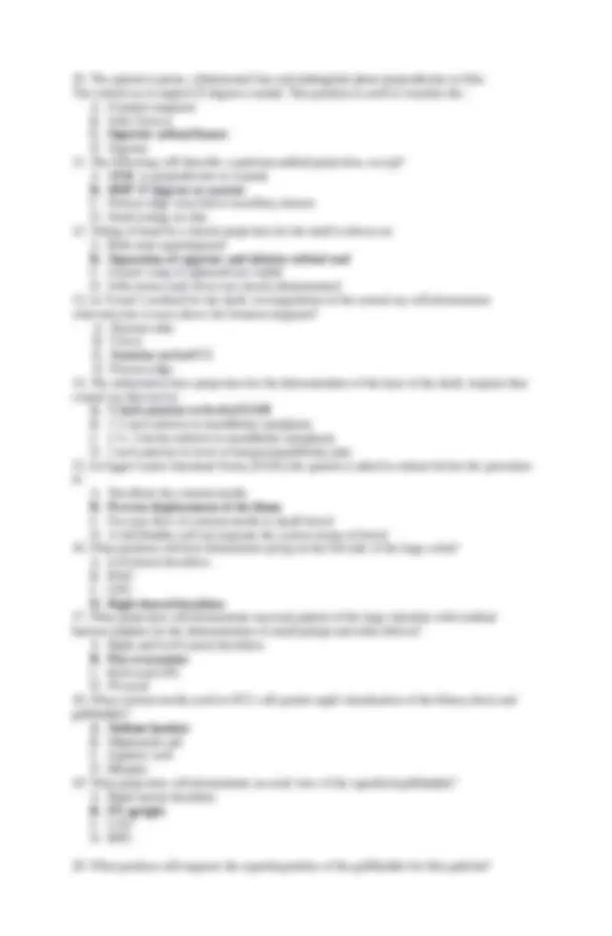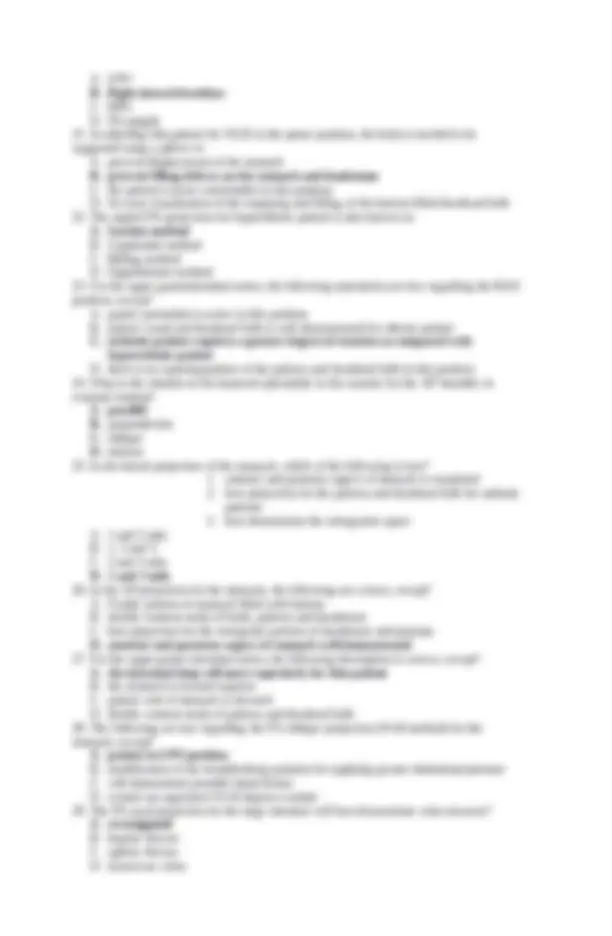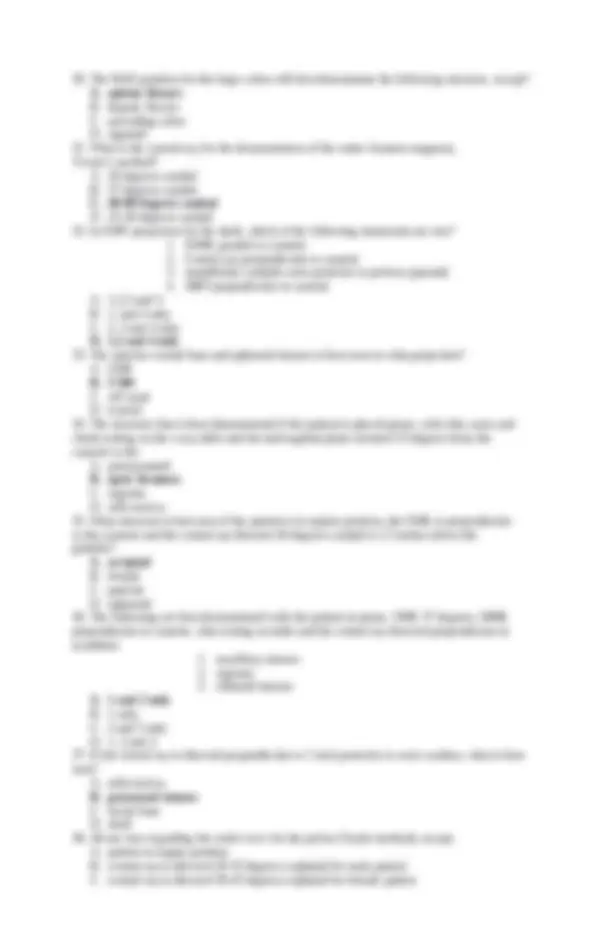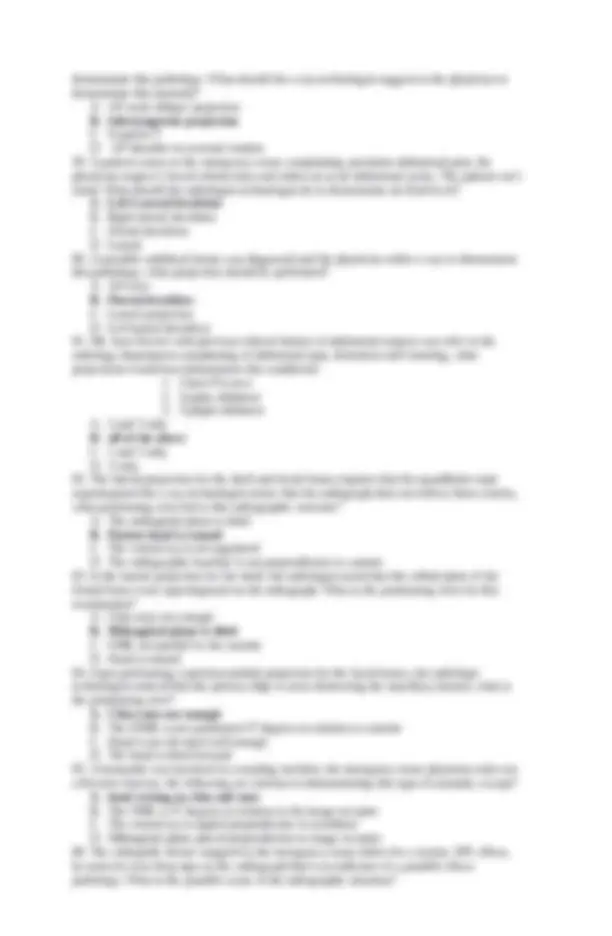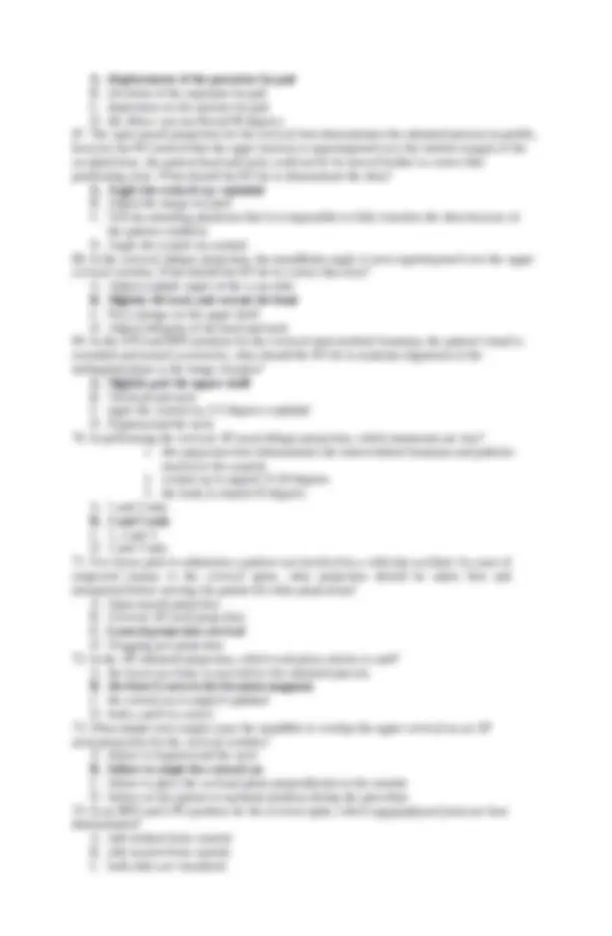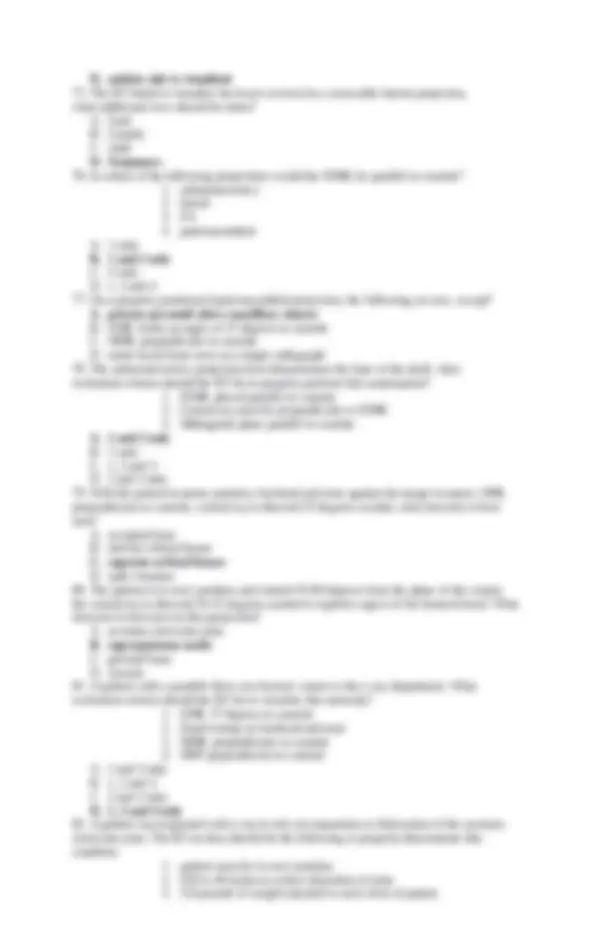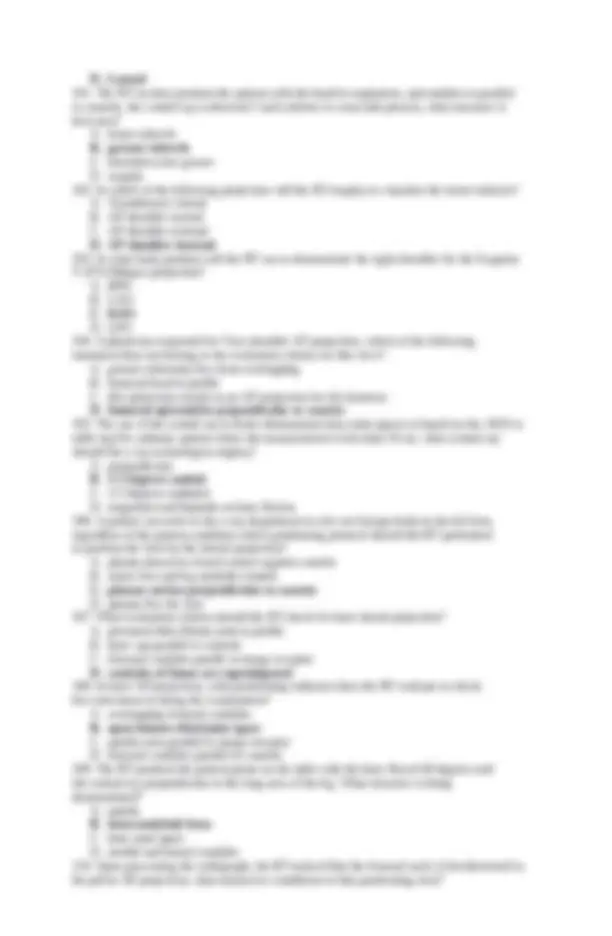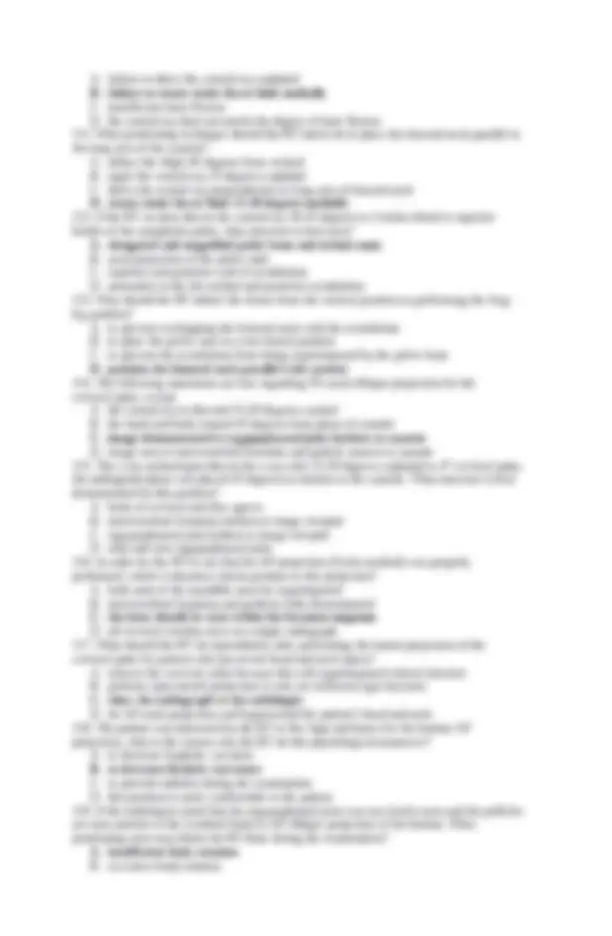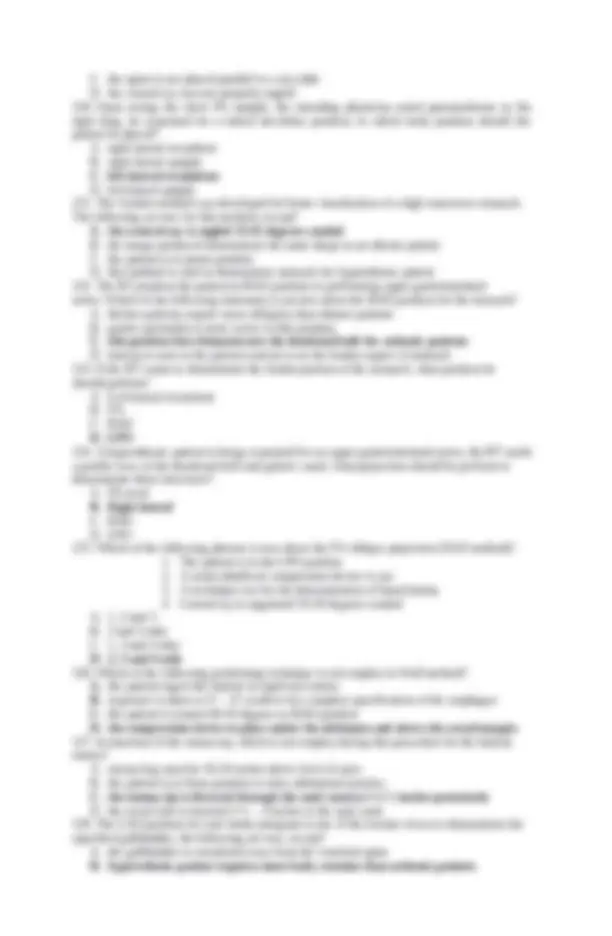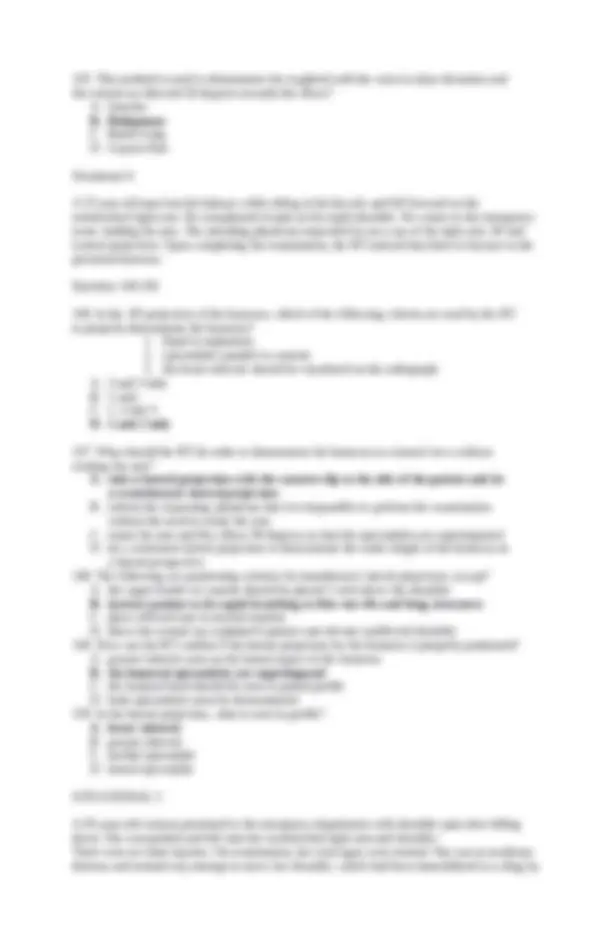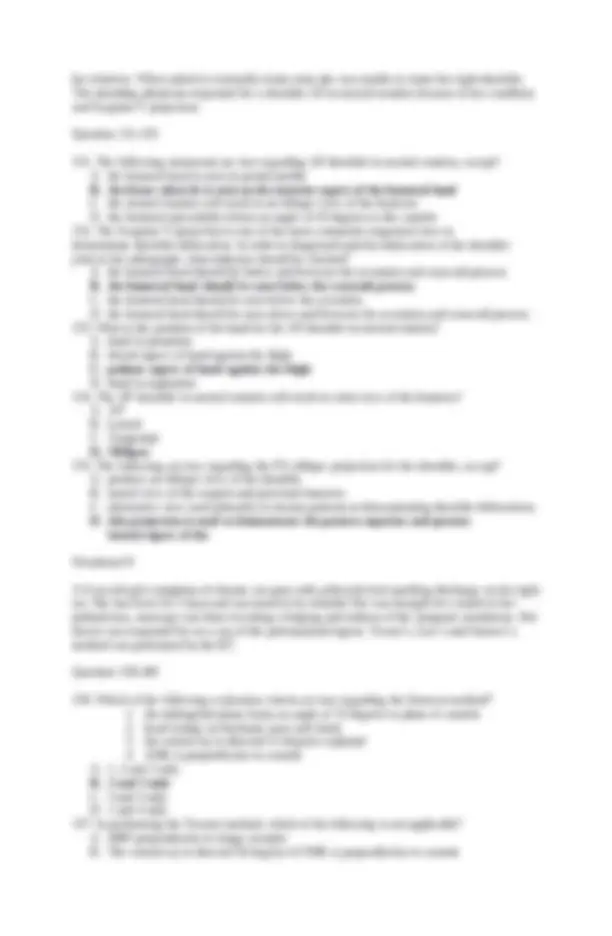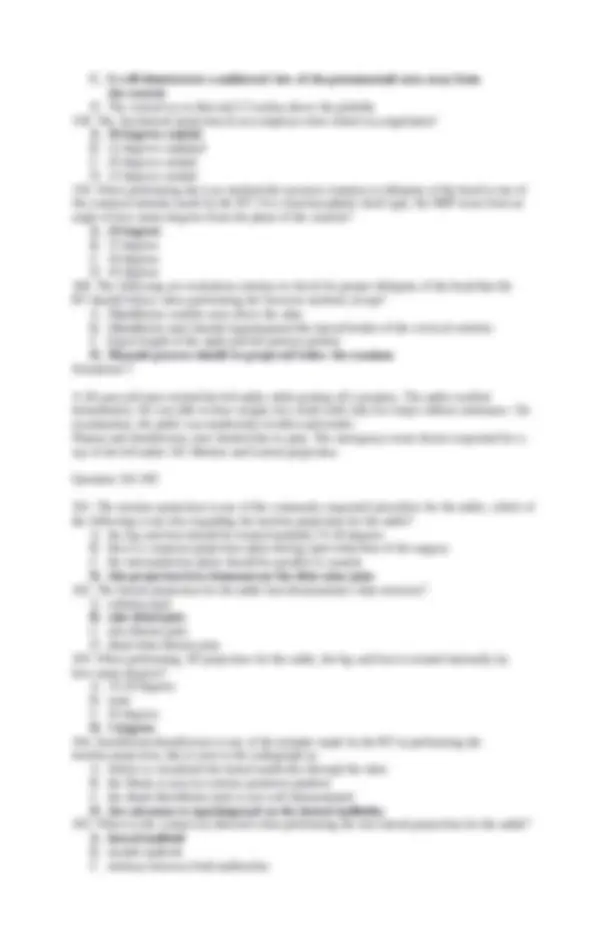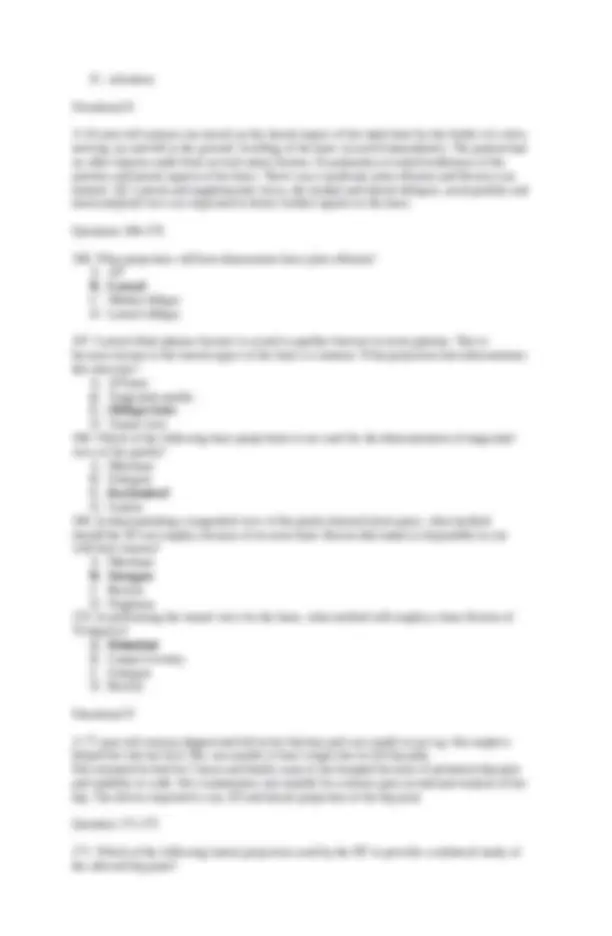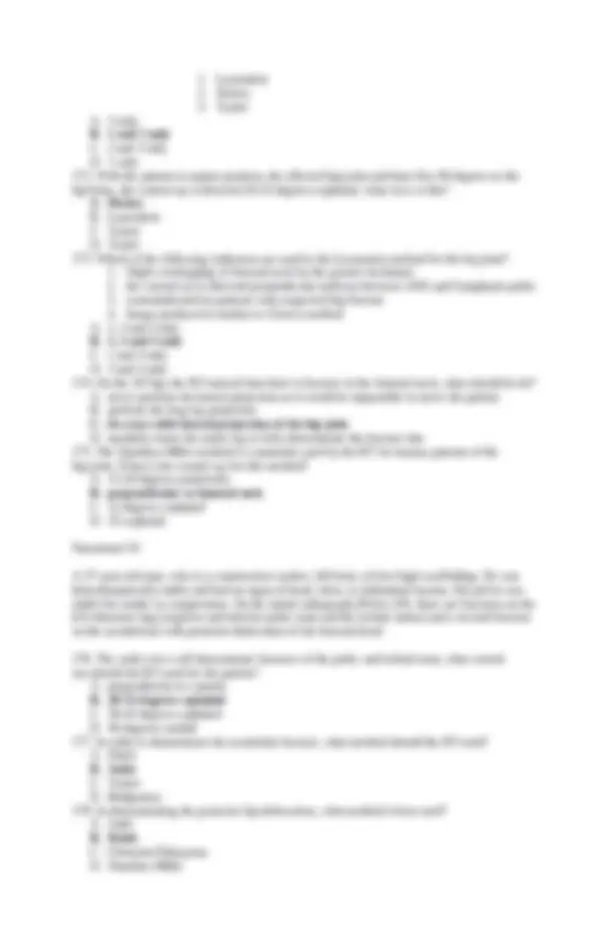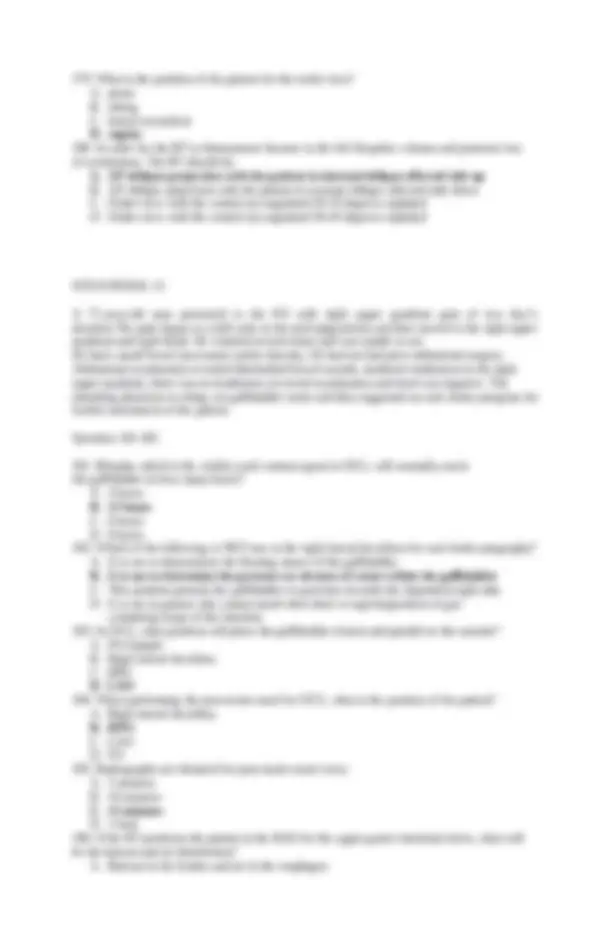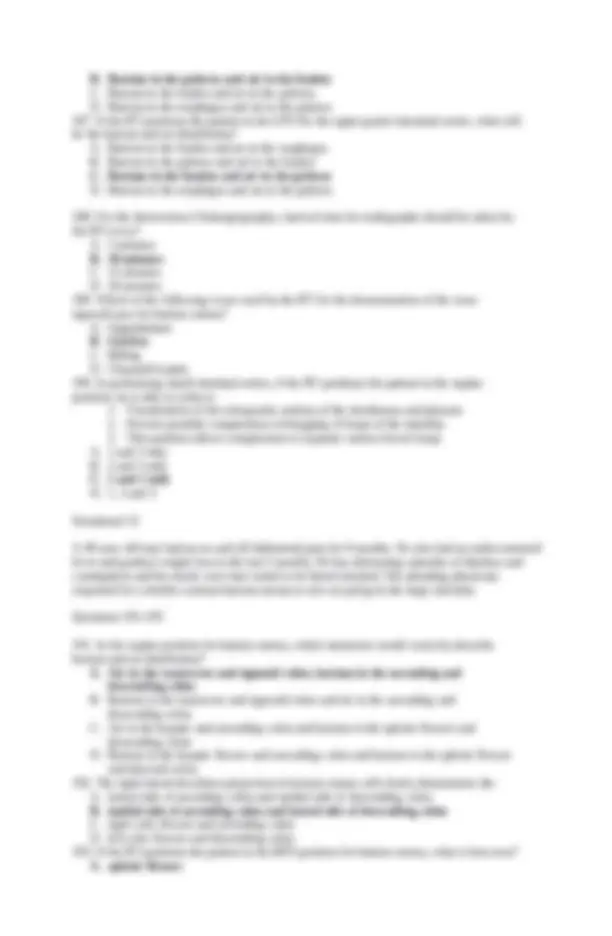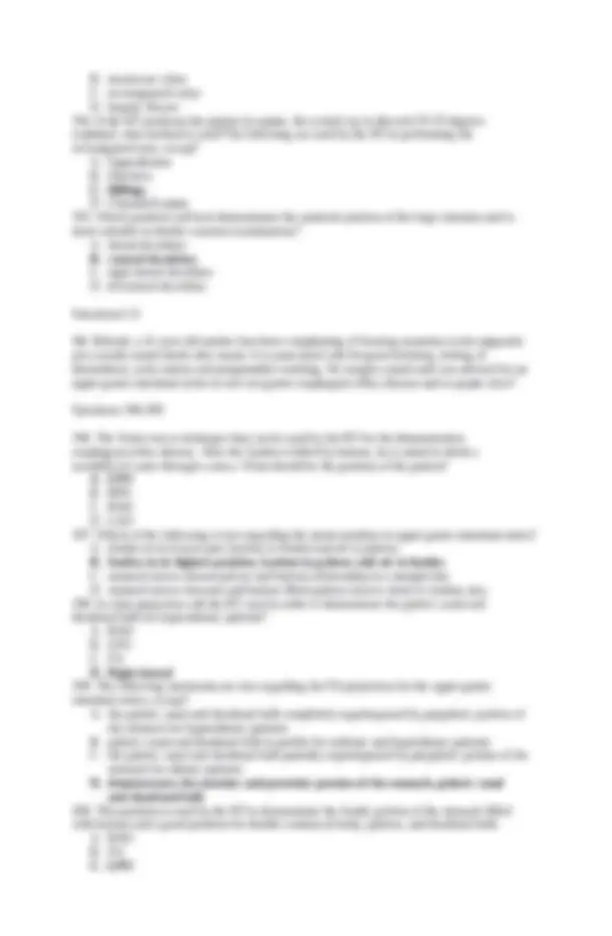Download ROC 1020 Radiographic Positions (South western university) and more Exams Radiology in PDF only on Docsity!
Radiographic- Positions- Extract- 2025
Bachelor of Science in Accountancy (Southwestern University
PHINMA)
2022 BORT BACK UP EXTRACT RADIOGRAPHIC POSITIONING
- The projection that best demonstrates all paranasal sinuses on a single radiograph is the: A. Parietoacanthial B. Submentovertico C. PA axial D. Lateral
- The cranial type in which the petrous ridge project antero-medial from the midsagittal plane at an angle of 40 degrees is describes as: A. Hypercephalic B. Mesocephalic C. Dolicocephalic D. Brachycephalic
- The parietoacanthial projection (Waters method) is employed for the evaluation of the foramen: A. Magnum B. Ovale C. Spinosum D. Rotundum
- The orbitoparietal oblique projection for the optic foramen requires the midsagittal plane form how many degrees to the cassette? A. 37 degrees B. 55 degrees C. 45 degrees D. 53 degrees
- In PA axial projection for demonstrating the paranasal sinuses is used primarily for the:
- Sphenoid sinuses
- Anterior ethmoid sinuses
- Maxillary sinuses
- Frontal sinuses A. 1 and 3 only B. 2 and 4 only C. 1,2 and 3 only D. 3 and 4 only
- The AP axial projection for the skull is employed for the demonstration of all of the following, except? A. Pars petrosa B. Paranasal sinuses C. Zygomatic arch D. Dorsum sella
- The HAAS method is often used to produce an image similar to: A. AP Axial B. PA axial C. Parietoacanthial D. Parieto-orbital oblique
- With the patient in prone position and the glabellomeatal line and midsagittal plane perpendicular to the cassette and the central ray is directed: A. 15 degrees caudad B. 23 degrees caudad C. 45 degrees caudad D. 37 degrees caudad
- In order to demonstrate the orbital floor and inferior orbital fissure using the PA axial projection (Bertel), the central ray is directed: A. 35 degrees caudad B. 25 degrees caudad C. 12 degrees cephalad D. 15 degrees caudad
A. LPO
B. Right lateral decubitus C. RPO D. PA upright
- In adjusting thin patient for UGIS in the prone position, the body is needed to be supported using a pillow to: A. prevent displacement of the stomach B. prevent filling defects on the stomach and duodenum C. the patient is more comfortable in this position D. for easy visualization of the emptying and filling of the barium filled duodenal bulb
- The angled PA projection for hypersthenic patient is also known as: A. Gordon method B. Gugliantini method C. Billing method D. Oppenheimer method
- For the upper gastrointestinal series, the following statements are true regarding the RAO position, except? A. gastric peristalsis is active in this position B. pyloric canal and duodenal bulb is well demonstrated for sthenic patient C. asthenic patient requires a greater degree of rotation as compared with hypersthenic patient D. there is no superimposition of the pylorus and duodenal bulb in this position
- What is the relation of the humeral epicondyle to the cassette for the AP shoulder in external rotation? A. parallel B. perpendicular C. oblique D. inferior
- In the lateral projection of the stomach, which of the following is true?
- anterior and posterior aspect of stomach is visualized
- best projection for the pylorus and duodenal bulb for asthenic patients
- best demonstrate the retrogastric space A. 1 and 2 only B. 1, 2 and 3 C. 2 and 3 only D. 1 and 3 only
- In the AP projection for the stomach, the following are correct, except? A. Fundic portion of stomach filled with barium B. double contrast study of body, pylorus and duodenum C. best projection for the retrogastic portion of duodenum and jejunum D. anterior and posterior aspect of stomach well demonstrated
- For the upper gastro intestinal series, the following description is correct, except? A. the intestinal loop will move superiorly for thin patient B. the stomach is located superior C. pyloric end of stomach is elevated D. double contrast study of pylorus and duodenal bulb
- The following are true regarding the PA oblique projection (Wolf method) for the stomach, except? A. patient in LPO position B. modification of the trendelenburg position for applying greater abdominal pressure C. will demonstrate possible hiatal hernia D. central ray angulated 10-20 degrees caudad
- The PA axial projection for the large intestine will best demonstrate what structure? A. rectosigmoid B. hepatic flexure C. splenic flexure D. transverse colon
- The RAO position for the large colon will best demonstrate the following structure, except? A. splenic flexure B. hepatic flexure C. ascending colon D. sigmoid
- What is the central ray for the demonstration of the entire foramen magnum, Towne’s method? A. 30 degrees caudad B. 37 degrees caudad C. 40-60 degrees caudad D. 25-30 degrees caudad
- In SMV projection for the skull, which of the following statements are true?
- IOML parallel to cassette
- Central ray perpendicular to cassette
- mandibular condyles seen posterior to petrous pyramid
- MSP perpendicular to cassette A. 1,2,3 and 4 B. 1, and 4 only C. 2, 3 and 4 only D. 1,2 and 4 only
- The anterior cranial base and sphenoid sinuses is best seen in what projection? A. SMV B. VSM C. AP axial D. Lateral
- The structure that is best demonstrated if the patient is placed prone, with chin, nose and cheek resting on the x-ray table and the mid-sagittal plane oriented 53 degrees from the cassette is the: A. petromastoid B. optic foramen C. zygoma D. sella turcica
- What structure is best seen if the patient is in supine position, the OML is perpendicular to the cassette and the central ray directed 30 degrees caudad to 2.5 inches above the glabella? A. occipital B. frontal C. parietal D. sphenoid
- The following are best demonstrated with the patient in prone, OML 37 degrees, MML perpendicular to cassette, chin resting on table and the central ray directed perpendicular to acanthion.
- maxillary sinuses
- zygoma
- ethmoid sinuses A. 1 and 2 only B. 1 only C. 2 and 3 only D. 1, 2 and 3
- If the central ray is directed perpendicular to 1 inch posterior to outer canthus, what is best seen? A. sella turcica B. paranasal sinuses C. facial bone D. skull
- All are true regarding the outlet view for the pelvis (Taylor method), except. A. patient in supine position B. central ray is directed 20-35 degrees cephalad for male patient C. central ray is directed 30-45 degrees cephalad for female patient
- With the patient in SMV position and the central ray directed perpendicular to 2 inches distal to symphysis menti, what is best seen? A. C1 and C B. Jugular foramina C. Rotundum foramina D. Odontoid process
- It demonstrates a lateral image of the styloid process superior to mandibular notch: A. Cahoon B. Fuch C. Wigby-Taylor D. Miller
- The styloid process is seen within or above the maxillary sinus, what method is being described? A. Kemp-Harper B. Lysholm C. Albers-Schonberg D. Cahoon
- The method that demonstrates the styloid process in an oblique view is the: A. Wigby-Taylor B. Cahoon C. Fuch D. Miller
- The attending physician requested for an axial image of the sphenoid sinus within the open mouth, what should the Rad Tech perform? A. Open-mouth waters B. Pirie method C. SMV D. Caldwell
- In AP axial oblique projection (Garth method), the radiologic technologist noted that the humerus is projected superiorly, this is an example of: A. Anterior dislocation B. Posterior dislocation C. Humeral neck fracture D. Hill-Sachs defect
- The following statements are true regarding AP axial projection for the shoulder, except? A. Acromion and acromioclavicular joint seen superior to the humeral head B. Coracoid process elongated and superimpose on humeral head C. Humeral head, glenoid fossa and head of scapula free of superimposition D. Medial and Lateral border of scapula are superimposed
- A patient is suffering from is impingement of the greater tuberosity and soft tissues on the coracoacromial ligamentous and osseous arch, he is having difficulty abducting his arm, what method will clearly demonstrate this pathology? A. Fisk B. Grashey C. Lawrence D. Neer
- A patient comes to the radiology department with a request of transthoracic lateral projection for the proximal humerus. He is in too much pain to drop the injured shoulder and is also having some difficulty in raising the uninjured arm. What should the radiologic technologist do in order to perform the examination correctly? A. angle the central ray caudad B. do not perform the procedure C. call the attending physician and tell him to pull the injured shoulder D. angle the central ray cephalad
- The emergency room physician suspects that a patient has anterior dislocation of the humeral head that may result in a compression fracture of the articular surface of the humeral head called the Hills-Sachs defect. He asked the x-ray technologist regarding the best projection to
demonstrate this pathology. What should the x-ray technologist suggest to the physician to demonstrate this anomaly? A. AP axial oblique projection B. Inferosuperior projection C. Scapular Y D. AP shoulder in external rotation
- A patient comes to the emergency room complaining persistent abdominal pain, the physician suspect’s bowel obstruction and orders an acute abdominal series. The patient can’t stand. What should the radiologist technologist do to demonstrate air-fluid level? A. Left Lateral decubitus B. Right lateral decubitus C. Dorsal decubitus D. Lateral
- A possible umbilical hernia was diagnosed and the physician orders x-ray to demonstrate this pathology, what projection should be performed? A. AP erect B. Dorsal decubitus C. Lateral projection D. Left lateral decubitus
- Mr. Juan Sievert with previous clinical history of abdominal surgery was refer to the radiology department complaining of abdominal pain, distention and vomiting, what projections would best demonstrate this conditions?
- Chest PA erect
- Supine abdomen
- Upright abdomen A. 2 and 3 only B. all of the above C. 1 and 3 only D. 3 only
- The lateral projection for the skull and facial bones requires that the mandibular rami superimposed the x-ray technologist notice that his radiograph does not follow these criteria, what positioning error led to this radiographic outcome? A. The midsagittal plane is titled B. Patient head is rotated C. The central ray is not angulated D. The radiographic baseline is not perpendicular to cassette
- In the lateral projection for the skull, the radiologist noted that the orbital plate of the frontal bone is not superimposed on the radiograph. What is the positioning error for this examination? A. Chin raise not enough B. Midsagittal plane is tilted C. OML not parallel to the cassette D. Head is rotated
- Upon performing a parietoacanthial projection for the facial bones, the radiologic technologist noticed that the petrous ridge is seen obstructing the maxillary sinuses, what is the positioning error? A. Chin raise not enough B. The IOML is not positioned 37 degrees in relation to cassette C. Head is not elevated well enough D. The head is tilted forward
- A bystander was involved in a mauling incident, the emergency room physician rules out a blowout fracture, the following are criterias in demonstrating this type of anomaly, except? A. head resting on chin and nose B. The OML is 37 degrees in relation to the image receptor C. The central ray is angled perpendicular to acanthion D. Midsagittal plane placed perpendicular to image receptor
- The orthopedic doctor assigned at the emergency room orders for a routine APL elbow, he noticed a tear drop sign on the radiograph that is an indicator of a possible elbow pathology. What is the possible cause of the radiographic situation?
D. neither side is visualized
- The RT failed to visualize the lower cervical in a cross-table lateral projection, what additional view should be taken? A. Fuch B. Grandy C. Judd D. Swimmers
- In which of the following projections would the IOML be parallel to cassette?
- submentovertico
- lateral
- PA
- parietoacanthial A. 1 only B. 1 and 2 only C. 2 only D. 1, 3 and 4
- On a properly positioned parietoacanthial projection, the following are true, except? A. petrous pyramid above maxillary sinuses B. OML forms an angle of 37 degrees to cassette C. MML perpendicular to cassette D. entire facial bone seen on a single radiograph
- The submentovertico projection best demonstrates the base of the skull, what evaluation criteria should the RT do to properly perform this examination?
- IOML placed parallel to cassette
- Central ray must be perpendicular to IOML
- Midsagittal plane parallel to cassette A. 1 and 2 only B. 1 only C. 1, 2 and 3 D. 2 and 3 only
- With the patient in prone position, forehead and nose against the image receptor, OML perpendicular to cassette, central ray is directed 25 degrees caudad, what structure is best seen? A. occipital bone B. inferior orbital fissure C. superior orbital fissure D. optic foramen
- The patient is in erect position and rotated 45-60 degrees from the plane of the casstte, the central ray is directed 10-15 degrees caudad to superior aspect of the humeral head. What structure is best seen in this projection? A. acromio-clavicular joint B. supraspinatus outlet C. glenoid fossa D. clavicle
- A patient with a possible blow-out fracture comes to the x-ray department. What evaluation criteria should the RT do to visualize this anomaly?
- OML 37 degrees to cassette
- Head resting on forehead and nose
- MML perpendicular to cassette
- MSP perpendicular to cassette A. 1 and 3 only B. 1, 2 and 4 C. 2 and 3 only D. 1, 3 and 4 only
- A patient was requested with x-ray to rule out separation or dislocation of the acromio- clavicular joint. The RT on duty should do the following to properly demonstrate this condition.
- patient must be in erect position
- SID is 40 inches to reduce distortion of joint
- 5-8 pounds of weight attached to each wrist of patient
- both joints included on the radiograph A. 2, 3 and 4 only B. 1, 3 and 4 only C. all of these D. 1 and 4 only
- Which positioning criteria should the RT follow in order to demonstrate the greater tubercle in profile?
- hand in supination
- epicondyles perpendicular to cassette
- central ray perpendicular to 2 inches inferior to coracoid process A. 2 and 3 only B. 1 only C. 1 and 3 only D. 2 only
- The AP shoulder in neutral rotation is generally used with trauma patients because the arm is not rotated in cases of acute injury. The following are evaluation criteria in performing this examination, except? A. place anterior aspect of hand against the hip joint B. the humeral epicondyles must be perpendicular to cassette C. the humerus must be in oblique position D. the central ray is directed perpendicular to coracoid process
- The following are true regarding infero-superior projection for the shoulder joint, except? A. arms abducted 90 degrees from the body B. central ray directed horizontally to shoulder joint C. a 15-20 degrees lateral angulation is used if patient can’t abduct arm fully D. this is used to demonstrate a lateral view of the proximal humerus
- The open-mouth projection is a supplemental view to demonstrate the upper cervical vertebra. The following are true, except? A. this projection best demonstrate atlas and axis zygapophyseal joint B. the upper margin of the lower incisor and mastoid tip is perpendicular to cassette C. Long SID to decrease magnification of the odontoid area D. this projection best demonstrate Jefferson’s fracture
- What landmark is place perpendicular to the base of the skull in the AP axial projection for the vertebral spine? A. occlusal plane B. symphysis menti C. zygapohyseal joint D. mentomeatal line
- What method should the RT perform when injuries to the elbow do not allow the patient to extend the elbow for routine obliques? A. Jones B. Coyle C. Lawrence D. Grashey
- The patient is unable to rotate his arm for a routine lateral projection for the humerus. What projection should the RT perform if there is acute trauma to the upper arm and shoulder? A. swimmers lateral B. transthoracic lateral C. wagging jaw D. inferosuperior
- It is alternative view perform by RT taken primarily to demonstrate possible humeral head dislocation and to provide an unobstructed view of the glenoid fossa. A. Neer B. Grashey C. Garth D. Grandy
- In the scapular Y projection, what positions will best demonstrate the right shoulder joint? A. RAO and RPO
D. Lateral
- The RT on duty position the patient with the hand in supination, epicondyles is parallel to cassette, the central ray is directed 1 inch inferior to coracoids process, what structure is best seen? A. lesser tubercle B. greater tubercle C. intertubercular groove D. scapula
- In which of the following projection will the RT employ to visualize the lesser tubercle? A. Transthoracic lateral B. AP shoulder neutral C. AP shoulder external D. AP shoulder internal
- In what body position will the RT use to demonstrate the right shoulder for the Scapular Y (PA Oblique) projection? A. RPO B. LAO C. RAO D. LPO
- A physician requested for True shoulder AP projection, which of the following statement does not belong to the evaluation criteria for this view? A. greater tuberosity free from overlapping B. humeral head in profile C. this projection results in an AP projection for the humerus D. humeral epicondyles perpendicular to cassette
- The use of the central ray to better demonstrate knee joint spaces is based on the ASIS to table top.For asthenic patient where the measurement is less than 19 cm, what central ray should the x-ray technologist employ? A. perpendicular B. 3-5 degrees caudad C. 3-5 degrees cephalad D. tangential and depends on knee flexion
- A patient was refer to the x-ray department to rule out foreign body in the left foot, regardless of the patient condition which positioning protocol should the RT performed to position the foot for the lateral projection? A. plantar placed in closed contact against cassette B. entire foot and leg medially rotated C. plantar surface perpendicular to cassette D. plantar flex the foot
- What evaluation criteria should the RT check for knee lateral projection? A. proximal tibio-fibular joint in profile B. knee cap parallel to cassette C. femoral condyles paralle to image receptor D. condyles of femur are superimposed
- In knee AP projection, what positioning indicator does the RT evaluate to check his correctness in doing the examination? A. overlapping femoral condyles B. open femoro-tibial joint space C. patella seen parallel to image receptor D. femoral condyles parallel to cassette
- The RT position the patient prone on the table with the knee flexed 40 degrees and the central ray perpendicular to the long axis of the leg. What structure is being demonstrated? A. patella B. intercondyloid fossa C. knee joint space D. medial and lateral condyles
- Upon processing the radiograph, the RT noticed that the femoral neck is foreshortened in his pelvis AP projection, what maneuver contributes to this positioning error?
A. failure to direct the central ray cephalad B. failure to rotate entire lower limb medially C. insufficient knee flexion D. the central ray does not match the degree of knee flexion
- What positioning technique should the RT intern do to place the femoral neck parallel to the long axis of the cassette? A. abduct the thigh 40 degrees from vertical B. angle the central ray 25 degrees cephalad C. direct the central ray perpendicular to long axis of femoral neck D. rotate entire lower limb 15-20 degrees medially
- If the RT on duty directs the central ray 30-45 degrees to 2 inches distal to superior border of the symphysis pubis, what structure is best seen? A. elongated and magnified pubic bone and ischial rami. B. axial projection of the pelvic inlet C. superior and posterior wall of acetabulum D. anomalies in the ilio-ischial and posterior acetabulum
- Why should the RT abduct the femur from the vertical position in performing the frog- leg position? A. to prevent overlapping the femoral neck with the acetabulum B. to place the pelvic area in a true lateral position C. to prevent the acetabulum from being superimposed by the pelvic bone D. position the femoral neck parallel with cassette
- The following statements are true regarding PA axial oblique projection for the cervical spine, except A. the central ray is directed 15-20 degrees caudad B. the head and body rotated 45 degrees from plane of cassette C. image demonstrated is zygapophyseal joint farthest to cassette D. image seen is intervertebral foramina and pedicle nearest to cassette
- The x-ray technologist directs his x-ray tube 15-20 degrees cephalad to 4 th^ cervical spine, the midsagittal plane was placed 45 degrees in relation to the cassette. What structure is best demonstrated by this position? A. body of cervical and disc spaces B. intervertebral foramina farthest to image receptor C. zygapophyseal joint farthest to image receptor D. atlas and axis zygapophyseal joint
- In order for the RT to say that his AP projection (Fuchs method) was properly performed, which evaluation criteria pertains to this projection? A. both rami of the mandible must be superimposed B. intervertebral foramina and pedicles fully demonstrated C. the dens should be seen within the foramen magnum D. all cervical vertebra seen on a single radiograph
- What should the RT do immediately after performing the lateral projection of the cervical spine for patient who has severe head and neck injury? A. remove the cervical collar because this will superimposed critical structure B. perform open mouth projection to rule out Jefferson type fractures C. show the radiograph to the radiologist D. do AP axial projection and hyperextend the patient’s head and neck
- The patient was instructed by the RT to flex hips and knees for the lumbar AP projection, what is the reason why the RT do this physiological maneuver? A. to decrease kyphotic curvature B. to decrease lordotic curvature C. to provide stability during the examination D. this position is more comfortable to the patient
- If the radiologist noted that the zygapophyseal joint was not clearly seen and the pedicles are seen anterior to the vertebral body in AP oblique projection of the lumbar. What positioning error may likely the RT done during the examination? A. insufficient body rotation B. excessive body rotation
C. patient is in semi prone position D. This is the most common basic position for the gallbladder
- A term for the radiographic examination of the biliary ducts? A. Cholecystography B. Cholangiogram C. Cholecystocholangiogram D. Cystogram Situational 1 3 days prior to consultation a 60 year old man complained of periumbilical and left lower quadrant abdominal pain. The pain was intermittent accompanied by vomiting. He had not developed similar pain in the past and had no previous abdominal surgery. The attending physician requested for an acute abdominal series to rule out small bowel obstruction. Question 130- 135
- What abdominal position will demonstrate possible air and fluid levels? A. AP supine abdomen B. Right lateral decubitus C. Left lateral decubitus D. AP erect abdomen
- The following are the routine projections for the acute abdominal series?
- Chest PA upright
- Supine abdomen
- Erect abdomen A. 1, 2 and 3 B. 2 and 3 only C. 3 only D. 1 and 2 only
- Presence of excessive fluid in the abdomen is best seen in what projection? A. AP erect B. AP supine C. Left lateral decubitus D. Dorsal decubitus
- If the patient is unable to stand for the upright abdomen, what is the alternative projection? A. Left lateral decubitus B. Dorsal decubitus C. Right lateral decubitus D. Ventral decubitus
- If the RT must include the diaphragm in the study to rule out possible pneumoperitoneum to the patient, where should he direct the central ray? A. perpendicular to iliac crest B. 2-3 inches above iliac crest C. perpendicular to ASIS D. perpendicular to level of 10 th^ thoracic
- What is the minimum amount of time should the patient in erect position prior to taking the examination? A. 10 minutes B. 15 minutes C. 5 minutes D. 20 minutes Situational 2 A 6 yr old boy fell on her outstretched right hand, he complained of pain localized to the right elbow. On examination there was tenderness and swelling. The attending physician requested for an x-ray of the elbow. There is a tear drop sign on the radiograph cause by the visualization of the elbow fat pad Question 136- 140
- What projection would best demonstrate the elbow fat pad?
A. AP
B. Lateral C. Medial oblique D. Lateral oblique
- Which of the following statements would describe on how to demonstrate the elbow fat pad? A. Hand in prone, epicondyles 45 degrees medially to cassette B. Hand in supination, epicondyles parallel to cassette C. Hand in external rotation, epicondyles 45 degrees laterally to cassette D. Hand in lateral position, epicondyles perpendicular to cassette
- In medial oblique elbow, the following structures are demonstrated except? A. trochlea in profile B. olecranon process within the olecranon fossa C. coronoid process in profile D. olecranon process without superimposition
- In the lateral projection for the elbow, if there is soft tissue injury around the affected elbow, how should the elbow be flexed? A. 90 degrees B. 45 degrees C. 30-35 degrees D. 20-30 degrees
- If the patient elbow is flexed more than 90 degrees, what is the alternative projection should the RT perform to demonstrate the olecranon process? A. Coyle method B. Jones method C. Grashey method D. Clements-Nakayama method Situational 3 The scaphoid is the most commonly fractured carpal bone and should be examined carefully when reviewing wrist radiographs. Scaphoid fractures are clinically significant because they can cause chronic disabling wrist pain. Tenderness and swelling on the anatomic snuffnox are the indicators for scaphoid fractures. Question 141- 145
- What is the other term for the scaphoid? A. navicular B. greater multangular C. lesser multangular D. unciform
- The following projections are used to demonstrate the scaphoid, except? A. ulnar deviation B. PA oblique wrist C. AP oblique wrist D. PA axial wrist
- A method for the demonstration of the scaphoid that uses multi central ray angulation. A. Bridgeman B. Rafert-Long C. Clements-Nakayama D. Stetcher
- The PA axial projection for the scaphoid employs, what central ray angulation? A. 20 degrees B. 45 degrees C. 10 degrees D. perpendicular to cassette
her relatives. When asked to externally rotate arms she was unable to rotate her right shoulder. The attending physician requested for a shoulder AP in neutral rotation because of her condition and Scapular Y projection. Question 151- 155
- The following statements are true regarding AP shoulder in neutral rotation, except? A. the humeral head is seen in partial profile B. the lesser tubercle is seen on the anterior aspect of the humeral head C. the neutral rotation will result in an oblique view of the humerus D. the humeral epicondyles forms an angle of 45 degrees to the cassette
- The Scapular Y projection is one of the most commonly requested view to demonstrate shoulder dislocation. In order to diagnosed anterior dislocation of the shoulder joint in the radiograph, what indicator should be checked? A. the humeral head should lie below and between the acromion and coracoid process B. the humeral head should be seen below the coracoid process C. the humeral head should be seen below the acromion D. the humeral head should be seen above and between the acromion and coracoid process
- What is the position of the hand for the AP shoulder in neutral rotation? A. hand in pronation B. dorsal aspect of hand against the thigh C. palmar aspect of hand against the thigh D. hand in supination
- The AP shoulder in neutral rotation will result in what view of the humerus? A. AP B. Lateral C. Tangential D. Oblique
- The following are true regarding the PA oblique projection for the shoulder, except? A. produce an oblique view of the shoulder B. lateral view of the scapula and proximal humerus C. alternative view used primarily to trauma patients in demonstrating shoulder dislocations D. this projection is used to demonstrate the postero-superior and postero lateral aspect of the Situational 6 A 8 yrs old girl complains of chronic ear pain with yellowish foul smelling discharge on her right ear. She has fever for 5 days and was noted to be irritable She was brought for consult to her pediatrician, otoscopy was done revealing a bulging and redness of the tympanic membrane. Her doctor was requested for an x-ray of the petromastoid region. Towne’s, Law’s and Stenver’s method was performed by the RT. Question 156- 160
- Which of the following evaluation criteria are true regarding the Stenvers method?
- the midsagittal plane forms an angle of 53 degrees to plane of cassette
- head resting on forehead, nose and cheek
- the central ray is directed 12 degrees cephalad
- AML is perpendicular to cassette A. 1, 2 and 3 only B. 2 and 3 only C. 3 and 4 only D. 1 and 4 only
- In performing the Townes method, which of the following is not applicable? A. MSP perpendicular to image receptor B. The central ray is directed 30 degrees if OML is perpendicular to cassette
C. It will demonstrate a unilateral view of the petromastoid area away from the cassette D. The central ray is directed 2.5 inches above the glabella
- The Axiolateral projection (Law) employs what central ray angulation? A. 10 degrees caudad B. 12 degrees cephalad C. 45 degrees caudad D. 15 degrees caudad
- When performing the Law method the incorrect rotation or obliquity of the head is one of the common mistake made by the RT. For a brachycephalic skull type, the MSP must form an angle of how many degrees from the plane of the cassette? A. 24 degrees B. 15 degrees C. 10 degrees D. 45 degrees
- The following are evaluation criterias to check for proper obliquity of the head that the RT should follow when performing the Stenvers method, except? A. Mandibular condyle seen above the atlas B. Mandibular rami should superimposed the lateral border of the cervical vertebra C. Equal length of the right and left petrous portion D. Mastoid process should be projected below the cranium Situational 7 A 26-year-old man twisted his left ankle while getting off a jeepney. The ankle swelled immediately. He was able to bear weight, but could walk only two steps without assistance. On examination, the ankle was moderately swollen and tender. Plantar and dorsiflexion were limited due to pain. The emergency room doctor requested for x- ray of the left ankle AP, Mortise and Lateral projection. Question 161- 165
- The mortise projection is one of the commonly requested procedure for the ankle, which of the following is not true regarding the mortise projection for the ankle? A. the leg and foot should be rotated medially 15-20 degrees B. this is a common projection taken during open reduction of the surgery C. the intermalleolar plane should be parallet to cassette D. this projection best demonstrate the tibio-talar joint
- The lateral projection for the ankle best demonstrates what structure? A. subtalar joint B. talo-tibial joint C. talo-fibular joint D. distal tibio-fibular joint
- When performing AP projection for the ankle, the leg and foot is rotated internally by how many degrees? A. 15-20 degrees B. none C. 45 degrees D. 5 degrees
- Insufficient dorsiflexion is one of the mistake made by the RT in performing the mortise projection, this is seen in the radiograph as: A. failure to visualized the lateral malleolus through the talus B. the fibula is seen in extreme posterior position C. the distal tibiofibular joint is not well demonstrated D. the calcaneus is superimposed on the lateral malleolus
- Where is the central ray directed when performing the true lateral projection for the ankle? A. lateral malleoli B. medial malleoli C. midway between both malleoulus

